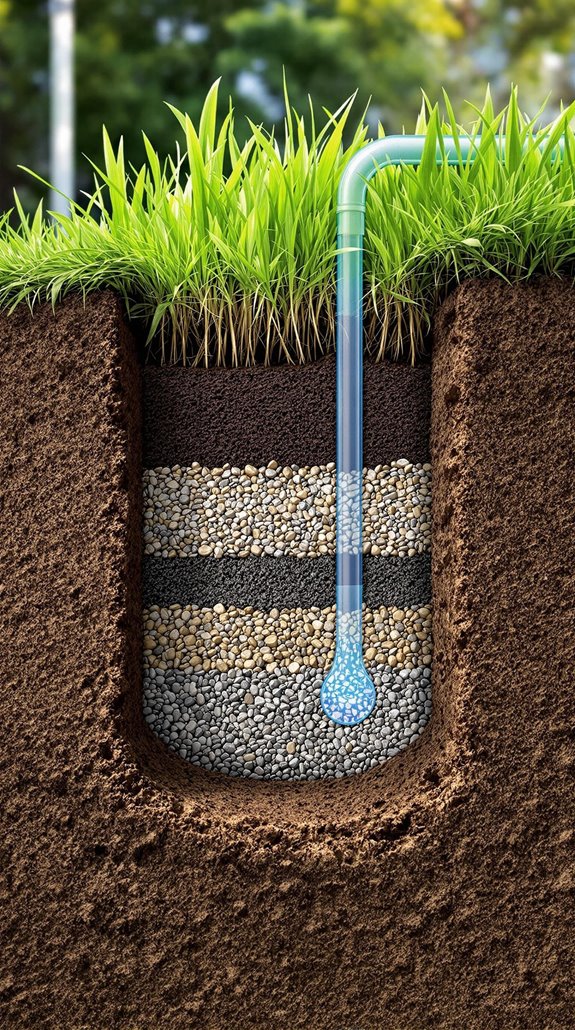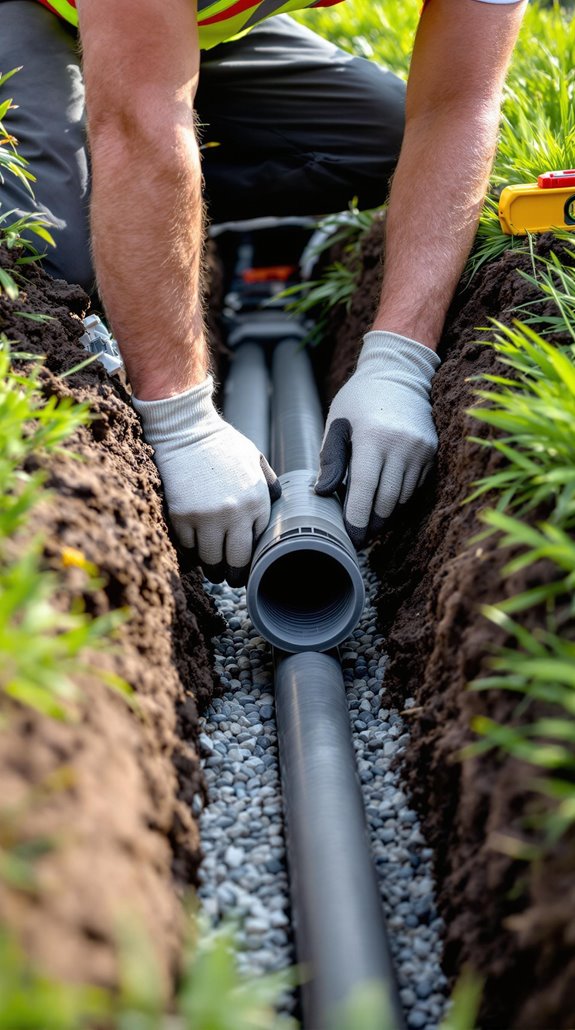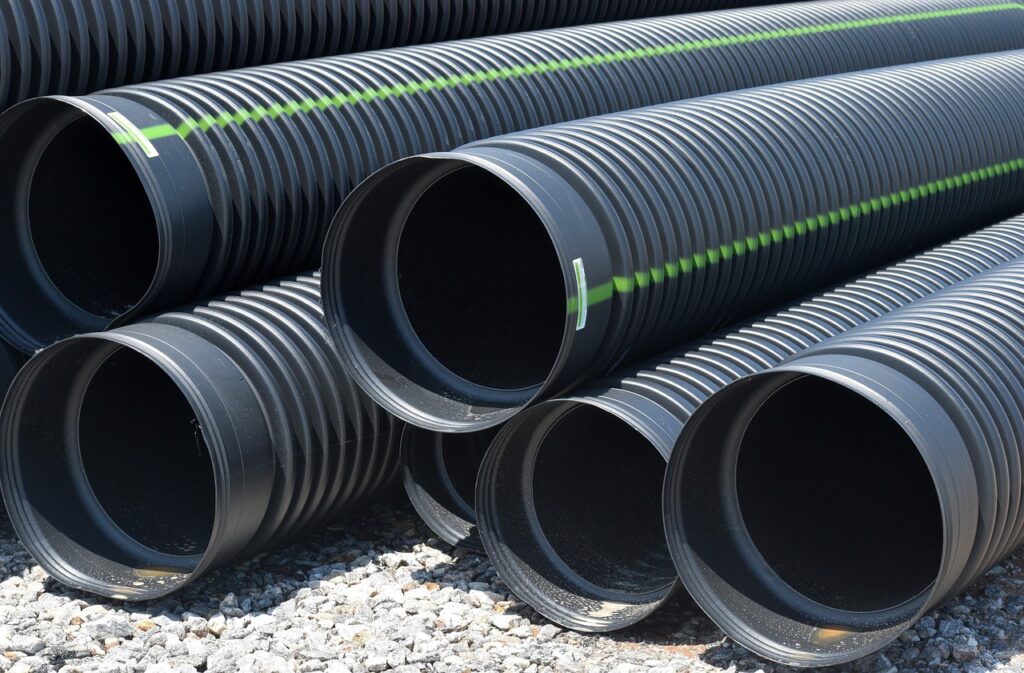I’ve witnessed countless UK homeowners struggle with waterlogged gardens and flooded driveways after heavy rainfall. If you’re dealing with persistent drainage issues, a soakaway system might be your most cost-effective solution. These underground structures work by collecting surface water and gradually releasing it into the surrounding soil, eliminating the need for expensive sewer connections. However, there’s more to successful soakaway installation than simply digging a hole – proper design and compliance with building regulations are essential for long-term effectiveness.
Key Takeaways
- Soakaways prevent surface water pooling by collecting rainwater and allowing gradual infiltration into surrounding soil naturally.
- UK Building Regulations Part H mandates soakaways for surface rainwater disposal with mandatory Building Control inspection required.
- Systems must be positioned 5-10 metres from buildings and require percolation tests to assess soil suitability.
- Installation eliminates expensive sewer connections while providing flood protection and preventing foundation damage during heavy rainfall.
- Maintenance involves annual inspections, quarterly cleaning, and percolation testing every 3-5 years for optimal performance.
What Is a Soakaway System and How Does It Work?

A soakaway system functions as an underground drainage solution that prevents surface water from pooling around your property by collecting rainwater and allowing it to gradually seep into the surrounding soil.
I’ll explain how this works practically. When rainwater hits your roof or driveway, it flows through gutters and drainage pipes into an excavated pit filled with rubble, stone, or plastic crates wrapped in geotextile membrane. The water temporarily pools in this underground chamber before gradually infiltrating the surrounding subsoil through gravity and natural soil porosity.
This process mimics natural drainage, preventing erosion and waterlogging by dispersing water volume over time. The system’s effectiveness depends on your soil conditions—sandy soils absorb quickly, while clay requires larger pits for proper function. Before installation, percolation tests are essential to assess whether your ground conditions are suitable for effective drainage performance.
Essential Components and Construction Materials for Soakaway Systems
While understanding how soakaway systems work provides the foundation, selecting the right components and materials determines whether your drainage solution will function effectively for decades or fail within years.
I’ll break down the essential components you’ll need. Soakaway crates form the system’s heart—these modular plastic units offer ≥95% void ratio for maximum water storage. You’ll wrap them in non-woven geotextile membrane to prevent silt ingress while maintaining water permeability.
For drainage pipework, use rigid PVC or flexible perforated pipes with integrated silt traps. Install these on a proper gradient from your downspouts to the crates.
Foundation materials include 150mm sharp sand base and 20-40mm coarse gravel backfill. Add inspection ports for maintenance access and consider concrete chambers for deeper installations. Remember that soakaways must be positioned 5 to 10 metres away from any building structures to ensure proper function and prevent foundation damage.
UK Building Regulations and Legal Requirements for Soakaways
Having the right materials means nothing if your soakaway doesn’t meet UK legal requirements. I’ll walk you through the critical regulations you can’t ignore.
Building Regulations Part H mandates soakaways for surface rainwater disposal in new homes. You’re only permitted to discharge to drains when infiltration methods prove impractical. Building Control inspection during excavation and assembly isn’t optional—it’s mandatory. This ensures compliance with approved planning permissions, which is essential to avoid potential fines in the future.
EU Directive 2000/60/EC prevents direct groundwater discharge, shaping UK soakaway design. You must avoid bypassing unsaturated zone attenuation to prevent contamination from road runoff. Boreholes or deep shafts require groundwater risk assessments and EPA agreement.
Your soakaway must comply with SuDS principles under environmental legislation. Non-compliance risks violating UK laws on pollutant introduction into groundwater—something we can’t afford. Homeowners with properly installed soakaways can claim a soakaway rebate from water companies, reducing sewerage bills by eliminating surface water drainage charges.
Key Benefits of Installing a Soakaway System
Once you’ve navigated the legal requirements, you’ll discover that soakaway systems deliver substantial benefits that extend far beyond regulatory compliance. I’ve seen firsthand how these systems transform property drainage challenges into sustainable solutions.
You’ll eliminate expensive sewer connections while using affordable materials like gravel or modular plastic crates. The passive design requires minimal maintenance—just periodic debris clearance from gutters. There’s no complex machinery to service or replace. Additionally, proper drainage systems, like Damp Proof Course, are critical to preventing moisture issues in your property.
Your property gains flood protection during heavy rainfall, preventing foundation damage and basement waterlogging. The system naturally recharges groundwater while reducing surface runoff pollution. You’re creating a sustainable stormwater management solution that works with diverse soil types.
Most importantly, you’ll join a community of property owners who’ve chosen environmentally responsible drainage that protects both their investment and local water systems. Regular inspections every 6 to 12 months ensure your soakaway maintains optimal performance throughout its lifespan.
Professional Installation Process and Maintenance Guidelines

Although soakaway systems appear straightforward, proper installation demands precise technical execution that I’ll guide you through step-by-step.
First, I’ll assess your soil’s permeability through percolation tests and measure the water table level. After calculating the required volume based on your catchment area, I’ll excavate the pit minimum 5 metres from buildings and lay a 150mm sharp sand base.
Next, I’ll connect the modular crates and wrap them in non-woven geotextile membrane, sealing all seams completely. The inlet pipe enters 10-15mm into the crate void with waterproof sleeves preventing silt ingress.
Finally, I’ll backfill with 20mm gravel in compacted layers and install permeable surfacing. This long-lasting solution provides effective drainage management that maintains property functionality through all weather conditions. You’ll need annual inspections, quarterly cleaning, and percolation testing every 3-5 years for peak performance.
Conclusion
I’ve covered everything you need to know about soakaways – from understanding how they work to meeting UK Building Regulations. You’ll save money on sewer connections while protecting your property from flooding. Remember, proper installation and regular maintenance are essential for long-term success. If you’re dealing with drainage issues, I’d recommend getting a percolation test done first to guarantee your soil’s suitable. Don’t skip the planning permission checks before you start construction.
References
- https://www.easymerchant.co.uk/blog/a-guide-to-soakaway-systems/
- https://www.homebuilding.co.uk/advice/soakaways
- https://www.drainagesuperstore.co.uk/help-and-advice/product-guides/underground-drainage/why-use-soakaway-crates-instead-of-rubble/
- https://boxallward.co.uk/rainwater-harvesting-sussex/all-you-need-to-know-about-rainwater-soakaways/
- https://www.drainfast.co.uk/blog/soakaway-systems-guide
- https://www.ukdpsolutions.co.uk/guides/what-is-a-soakaway
- https://blockbusters.co.uk/blog/what-is-a-soakaway/
- https://geosmartinfo.co.uk/2019/09/soakaway/
- https://outdooraggregates.com/diy/drainage/gravel-garden-drainage-soakaway/
- https://www.kent.gov.uk/__data/assets/pdf_file/0014/13037/Making-it-Happen-Soakaway-design-guide-July-2000.pdf

